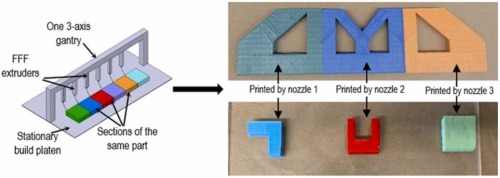Researchers at Rutgers University have developed a technique they called “multiplexed fused filament fabrication (MF3)“. MF3 sees multiple nozzles mounted onto a single gantry that moves while the build platform itself stays still. Unlike STACKER or other processes that have multiple nozzles simultaneously move along the same path making identical copies of the same object, the nozzle flow for MF3 can be turned on and off, with nozzles printing different areas of the same part or different parts simultaneously. This makes it possible to produce multiple parts at the same time or to have many nozzles work on one part simultaneously. Additionally, by deploying many nozzles, large parts can be printed that were not feasible before. The Rutgers team hopes that the process can accelerate 3D printing while increasing resolution.

“We have more tests to run to understand the strength and geometric potential of the parts we can make, but as long as those elements are there, we believe this could be a game changer for the industry. MF3 will change how thermo-plastic printing is done,” said researcher Jeremy Cleman.
MF3 works by optimizing gantry behavior and nozzle flow via software and slicing. By studying the temperature over time, the team can further understand the dynamics of what is happening and how to optimize slicing and the movement of the nozzles. From what I can tell, they’ve basically optimized retraction and studied under- and over-extrusion to enhance the 3D printing process depending on the geometry. Smart!
This is reminiscent of what is possible with the Sculpman nozzle, which can change nozzle diameters within an individual build. It also brings to mind what the capabilities of Full Control, which I described as follows:
“What also excites me is the prospect of recoding models for manufacturing. Imagine you just have one headphone model made in CAD. Now, you’ve gotten 100 orders for it. You look at the errors your printer is making in over-extrusion or examine parts where the print doesn’t look nice and then you recode the entire model in FullControl to optimize it. You can adjust the particular parameters specifically for one location by optimizing the settings for that location.
“Now, imagine you get 10,000 orders for the model. You can place ten on a bed and now you can recode each individual model per bed placement to optimize them all. You can change all of the specific parameters to optimally 3D print that one particular model. You can also use this to make very specific textures or internal structures. You could generate a variable infill structures at every single location. It’s like printing directly from the command line while also allowing you to modify every voxel.”

That idea was to optimize for such printer behaviors like stepper motor acceleration or extruder retraction via better Gcode for each model, curve, line or part of a model. The Rutgers team seems to have gone further than this by allowing for stopping and unstopping of flow. This is a potentially interesting approach. In the paper the team says,
¨MF3 prints concurrently with multiple FFF extruders without controlling each extruder motion’s individually by using a new toolpath strategy that is rooted in our discovery of continuous filament retraction and advancement.¨
Their tool path strategy furthermore makes it possible to ¨“concurrently print multiple, geometrically distinct, non-contiguous parts of varying sizes.” The team say that they can use regular 3D printer hardware. Furthermore nozzles can now become redundant and be replaced easily with other nozzles continuing to do their work. I like that this kind of an approach also seems to work well with multiple tool heads. So, it would seem to be efficient to use this setup with other tools, as well. All in all, this seems like a really interesting idea.
Subscribe to Our Email Newsletter
Stay up-to-date on all the latest news from the 3D printing industry and receive information and offers from third party vendors.
You May Also Like
3D Printing News Briefs, April 13, 2024: Robotics, Orthotics, & Hypersonics
In 3D Printing News Briefs today, we’re focusing first on robotics, as Carnegie Mellon University’s new Robotics Innovation Center will house several community outreach programs, and Ugogo3D is now working...
Rail Giant Alstom Saves $15M with 3D Printing Automation Software 3D Spark
3D Spark has entered into a three-year deal with the rail giant Alstom. Alstom, a transport behemoth with annual revenues of $16 billion, specializes in the manufacture of trains, trams,...
Meltio Expands Global Reach with New Partnerships in the Americas and Europe
Spanish 3D printing manufacturer Meltio has expanded its sales network across the globe. With the addition of three new partners in the United States, Brazil, Argentina, and Italy, Meltio aims...
3D Printing Webinar and Event Roundup: April 7, 2024
Webinars and events in the 3D printing industry are picking back up this week! Sea-Air-Space is coming to Maryland, and SAE International is sponsoring a 3D Systems webinar about 3D...































